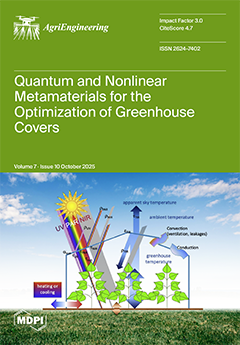Recent advances in hyperspectral imaging (HSI) and multimodal deep learning have opened new opportunities for crop health analysis; however, most existing models remain limited by dataset scope, lack of interpretability, and weak cross-domain generalization. To overcome these limitations, this study introduces Agri-DSSA, a
[...] Read more.
Recent advances in hyperspectral imaging (HSI) and multimodal deep learning have opened new opportunities for crop health analysis; however, most existing models remain limited by dataset scope, lack of interpretability, and weak cross-domain generalization. To overcome these limitations, this study introduces Agri-DSSA, a novel Dual Self-Supervised Attention (DSSA) framework that simultaneously models spectral and spatial dependencies through two complementary self-attention branches. The proposed architecture enables robust and interpretable feature learning across heterogeneous data sources, facilitating the estimation of spectral proxies of chlorophyll content, plant vigor, and disease stress indicators rather than direct physiological measurements. Experiments were performed on seven publicly available benchmark datasets encompassing diverse spectral and visual domains: three hyperspectral datasets (Indian Pines with 16 classes and 10,366 labeled samples; Pavia University with 9 classes and 42,776 samples; and Kennedy Space Center with 13 classes and 5211 samples), two plant disease datasets (PlantVillage with 54,000 labeled leaf images covering 38 diseases across 14 crop species, and the New Plant Diseases dataset with over 30,000 field images captured under natural conditions), and two chlorophyll content datasets (the Global Leaf Chlorophyll Content Dataset (GLCC), derived from MERIS and OLCI satellite data between 2003–2020, and the Leaf Chlorophyll Content Dataset for Crops, which includes paired spectrophotometric and multispectral measurements collected from multiple crop species). To ensure statistical rigor and spatial independence, a block-based spatial cross-validation scheme was employed across five independent runs with fixed random seeds. Model performance was evaluated using
, RMSE, F1-score, AUC-ROC, and AUC-PR, each reported as mean ± standard deviation with 95% confidence intervals. Results show that Agri-DSSA consistently outperforms baseline models (PLSR, RF, 3D-CNN, and HybridSN), achieving up to
for chlorophyll content estimation and F1-scores above 0.95 for plant disease detection. The attention distributions highlight physiologically meaningful spectral regions (550–710 nm) associated with chlorophyll absorption, confirming the interpretability of the model’s learned representations. This study serves as a methodological foundation for UAV-based and field-deployable crop monitoring systems. By unifying hyperspectral, chlorophyll, and visual disease datasets, Agri-DSSA provides an interpretable and generalizable framework for proxy-based vegetation stress estimation. Future work will extend the model to real UAV campaigns and in-field spectrophotometric validation to achieve full agronomic reliability.
Full article





